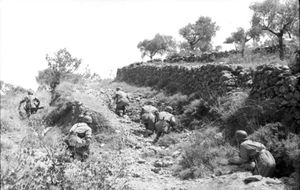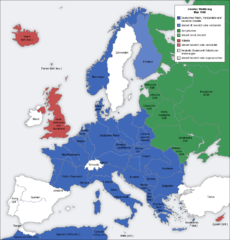حملة البلقان (الحرب العالمية الثانية)
| حملة البلقان | |||||||||
|---|---|---|---|---|---|---|---|---|---|
| جزء من مسرح عمليات المتوسط والشرق الأوسط في الحرب العالمية الثانية | |||||||||
 المظليون الألمان في كريت، في 1941 | |||||||||
| |||||||||
| المتحاربون | |||||||||
|
Axis: |
Allies: | ||||||||
| القادة والزعماء | |||||||||
|
|
| ||||||||
| القوى | |||||||||
|
|
| ||||||||
حملة البلقان في الحرب العالمية الثانية بدأت بالغزو الإيطالي لليونان في 28 أكتوبر 1940. وفي أوائل 1941، أوقِف الهجوم الإيطالي واندفع الهجوم اليوناني المضاد في ألبانيا. سعت ألمانيا، بنشر قواتها في رومانيا وبلغاريا، لمساعدة إيطاليا بمهاجمة اليونان من الشرق؛ بينما وصلت القوات والطيران البريطانية لدعم الدفاعات اليونانية. تسبب انقلاب في يوغسلاڤيا في 27 مارس في إصدار هتلر لأمر بغزو ذلك البلد.
غزو يوغسلاڤيا من قِبل ألمانيا وإيطاليا بدأ في 6 أبريل، بالتزامن مع معركة اليونان الجديدة. وفي 11 أبريل، المجر انضمت للقوات الغازية. وبحلول 17 أبريل كان اليوغسلاڤ قد وقعوا هدنة وبحلول 30 أبريل كانت البر الرئيسي لليونان بأكمله تحت السيطرة الألمانية أو الإيطالية. وفي 20 مايو غزت ألمانيا كريت جواً وبحلول 1 يونيو استسلمت كل القوات البريطانية على الجزيرة. وبالرغم من أنها لم تشارك في الهجمات في أبريل، فقد احتلت بلغاريا أجزاءً من كل من يوغسلاڤيا واليونان بعد وقت وجيز وظلت محتفظة بها طيلة زمن الحرب بالبلقان.
خلفية
بعد الحرب العالمية الأولى، مع الانهيار التام لكل من الدولة العثمانية والامبراطورية النمساوية-المجرية، تطلع الألبان إلى مملكة إيطاليا لحمايتهم من أعدائهم.
في 1919, Albania's territorial integrity was confirmed at the مؤتمر پاريس للسلام after United States President Woodrow Wilson opposed a plan by the European powers to divide Albania amongst its neighbors. There were attempted backroom negotiations that ultimately failed.
However, after 1925, Italian dictator Benito Mussolini sought to dominate Albania.
في 1928، أصبحت ألبانيا مملكة يحكمها زغو الأول. Zog was a clan chief and former رئيس وزراء. Zog failed to stave off Italian ascendancy in Albanian internal affairs.
On 7 April 1939, Mussolini's troops occupied Albania, overthrew Zog, and annexed the country to the الامبراطورية الإيطالية.
الحملة
الحرب الإيطالية اليونانية
الحرب الإيطالية اليونانية lasted from 28 October 1940 to 30 April 1941 and was part of الحرب العالمية الثانية. Italian forces invaded Greece and made limited gains. But soon the Greeks counter-attacked and the Italians were repulsed and driven back into Albania. The Italians spent much of the winter stabilizing a line which left them in control of only about two-thirds of Albania. A much anticipated Italian offensive in March 1941 failed to make sufficient progress. Germany intervened in April and invaded Greece after a successful invasion of Yugoslavia.
غزو يوغسلاڤيا
غزو يوغسلاڤيا (also known as "Operation 25") began on 6 April 1941 and ended with the unconditional surrender of the Royal Yugoslav Army on 17 April. The invading Axis powers (Nazi Germany, Fascist Italy, and Hungary) occupied and dismembered the Kingdom of Yugoslavia. By cobbling together Bosnia and Herzegovina, some parts of Croatia, and Syrmia, the "Independent State of Croatia" (Nezavisna Država Hrvatska, NDH) was created by Germany and Italy. In some of the territory of the former Kingdom of Serbia and the Banat, the German-occupied Territory of the Military Commander in Serbia, the Germans appointed a puppet government, the Government of National Salvation led by Milan Nedić. Montenegro remained under Italian occupation, and Bulgaria was permitted to annex eastern areas of Yugoslavia, including most of modern-day مقدونيا.
معركة اليونان
Hitler began planning to invade Greece in November 1940, after the British occupied Crete and Lemnos. He ordered the German Invasion of Greece — code-named Unternehmen Marita (Operation Marita) by Germany — on 13 December 1940 for execution in March 1941. The stated aim of the operation was to prevent the British from getting air bases within striking range of the Romanian oilfields.[1] On 6 April 1941, the German Army invaded northern Greece, while other elements launched an attack against Yugoslavia. Breaking through the Yugoslav lines in southern Yugoslavia allowed Germany to send reinforcements to the battlefields of northern Greece. The German army out-flanked the Greek Metaxas Line fortifications and, despite the assistance provided by a British expeditionary corps, set out to capture the southern Greek cities. The Battle of Greece ended with the German entry into Athens and the capture of the Peloponnese, although about 40,000 Allied soldiers were evacuated to Crete, prompting one of the largest airborne attacks in the history of warfare: Operation Merkur, or the Battle of Crete.
معركة كريت
On 20 May 1941, German paratroopers were dropped over the airfields of northern Crete to occupy the island. They were met by heavy resistance from Allied forces and the local Cretan population but eventually the defenders were overwhelmed by the tactically superior German forces. The British Government ordered an evacuation on 27 May and the remaining forces surrendered on 1 June. However, the heavy losses incurred by the paratroopers forced the Supreme Command of the Wehrmacht to abandon large-scale airborne operations for the remainder of the war.

النتيجة
By 1 June 1941, all of Albania, Yugoslavia and Greece were under Axis control. Greece was placed under triple occupation, and Yugoslavia was dissolved and occupied. Germany had gained a significant strategic advantage: direct access to the Mediterranean. The Allied High Command feared that Crete and Greece would be used as "springboard" for an invasion of British Egypt or Cyprus. However, any plans for a large-scale invasion of Egypt and Palestine were abandoned when Operation Barbarossa commenced on 22 June. The effect of the Balkans Campaign on the outcome of Operation Barbarossa is still debated to this day.
الاحتلال البلغاري
On 6 April 1941, despite having officially joined the Axis Powers, the Bulgarian government did not participate in the invasion of Yugoslavia and the Battle of Greece. As German, Italian, and Hungarian troops crushed Yugoslavia and Greece, the Bulgarians remained on the side-lines. The Yugoslav government surrendered on 17 April. The Greek government was to hold out until 30 April. On 20 April, the Bulgarian Army occupied most of Western Thrace and the Greek province of Eastern Macedonia, which had been already conquered by Germany, with the goal of restoring its pre-الحرب العالمية الأولى outlet to the Aegean Sea. Bulgarian troops also occupied much of eastern Serbia, where the so-called Vardar Banovina was divided between Bulgaria and the Italians.
حركات المقاومة
Throughout the remainder of the war, active Yugoslav, Greek, and Albanian resistance movements forced Germany and its allies to garrison hundreds of thousands of soldiers permanently in the three countries, denying them to the other fronts. Especially in Yugoslavia after 1943, the threat of an Allied invasion and the activities of the partisans necessitated large-scale counter-insurgency operations, involving several divisions, including elite Mountain Infantry (Gebirgsjäger) units.
انظر أيضاً
الهامش
- ^ Hubatsch, Walther. Hitlers Weisungen fuer die Kriegfuehrung 1939-1945, Weisung Nr. 20, 2nd Edition, Bernard & Graefe Verlag, 1983
للاستزادة
- The German campaigns in the Balkans (Spring 1941). Historical Study. United States Army Center of Military History. 1986 [1953]. CMH Pub 104-4.
